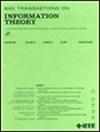有效实现列表解码能力的Reed-Solomon码的显式子码
IF 2.9
3区 计算机科学
Q3 COMPUTER SCIENCE, INFORMATION SYSTEMS
引用次数: 0
摘要
本文介绍了一种显式RS码的子码族,该子码族可以在输出列表大小不变的情况下有效地实现列表解码能力。代码是通过最初形成两个RS码的张量积和精心选择的评估集来构建的,然后对码字行进行特定的循环移位。这个过程导致每个码字列被视为一个单独的坐标,使人联想到先前的容量实现代码,例如折叠RS码和单变量多重码。这种结构很容易显示为交错RS码的子码,相当于在子域上求值的RS码。或者,码可以通过对两个仿射变换产生的轨道上的二元多项式进行评估来构建,这扩展了早先在折叠RS码中使用单个仿射变换和最近由Bhandari等人引入的仿射折叠RS码(IEEE T-IT, Feb. 2024)。虽然我们的码需要大而恒定的特征,但与单变量多重码相比,这两个仿射变换有助于实现码长等于字段大小,而不受字段为素数的限制。本文章由计算机程序翻译,如有差异,请以英文原文为准。
Explicit Subcodes of Reed-Solomon Codes That Efficiently Achieve List Decoding Capacity
In this paper, we introduce an explicit family of subcodes of Reed-Solomon (RS) codes that efficiently achieve list decoding capacity with a constant output list size. The codes are constructed by initially forming the tensor product of two RS codes with carefully selected evaluation sets, followed by specific cyclic shifts to the codeword rows. This process results in each codeword column being treated as an individual coordinate, reminiscent of prior capacity-achieving codes, such as folded RS codes and univariate multiplicity codes. This construction is easily shown to be a subcode of an interleaved RS code, equivalently, an RS code evaluated on a subfield. Alternatively, the codes can be constructed by the evaluation of bivariate polynomials over orbits generated by two affine transformations with coprime orders, extending the earlier use of a single affine transformation in folded RS codes and the recent affine folded RS codes introduced by Bhandari et al. (IEEE T-IT, Feb. 2024). While our codes require large, yet constant characteristic, the two affine transformations facilitate achieving code length equal to the field size, without the restriction of the field being prime, contrasting with univariate multiplicity codes.
求助全文
通过发布文献求助,成功后即可免费获取论文全文。
去求助
来源期刊

IEEE Transactions on Information Theory
工程技术-工程:电子与电气
CiteScore
5.70
自引率
20.00%
发文量
514
审稿时长
12 months
期刊介绍:
The IEEE Transactions on Information Theory is a journal that publishes theoretical and experimental papers concerned with the transmission, processing, and utilization of information. The boundaries of acceptable subject matter are intentionally not sharply delimited. Rather, it is hoped that as the focus of research activity changes, a flexible policy will permit this Transactions to follow suit. Current appropriate topics are best reflected by recent Tables of Contents; they are summarized in the titles of editorial areas that appear on the inside front cover.
 求助内容:
求助内容: 应助结果提醒方式:
应助结果提醒方式:


